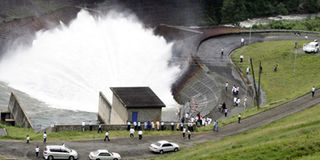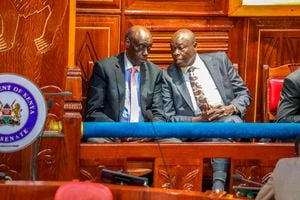Kenya moves to meet water demands of thirsty citizens

Citizens marvel as water gushes into the Ndakaini Dam in Thika at the weekend. The dam, which supplies Nairobi, is full to capacity but officials say rationing for city residents will continue. Photo/JAMES NJUGUNA
Kenya is in the dubious league of countries that are yet to meet the water needs of their citizens.
Rationing is a perennial headache for urban residents while in many rural areas, women and children have to walk long distances to fetch water. But these tribulations could end if a new programme started by the National Water Conservation and Pipeline Corporation bears fruit.
The parastatal has launched a multi-billion shilling initiative involving borehole drilling, dam building as well as rehabilitating existing ones to boost supplies. The massive initiative seeks to tap the flood waters going to waste in most parts of the country while a majority of residents live with dry taps.
It is estimated that 1,700 cubic metres per capita per year is the minimum amount of water required to maintain an adequate quality of life. On the global index, Kenya, with a per capita water availability of 635 cubic metres, is considered a water-scarce nation and this may worsen by 2025 when it hits a low of 190 cubic metres.
In light of this bleak outlook, the NWCPC is investing billions in water harvesting infrastructure countrywide. And next month, Machakos Town, just outside Nairobi, could join Eldoret as one of the few urban centres whose water resources surpass their needs, thanks to the rehabilitation of Maruba Dam.
An hour’s drive from Nairobi, Machakos could in future be the next stop for residents as water costs and rents go through the roof in city estates. Built in the 1950s, Maruba Dam is set to increase daily water supply for Machakos from 2,000 to 8,500 cubic metres. The dam will store 2.45 million cubic metres.
NWCPC’s efforts will also see outlying towns like Ongata Rongai, Ngong and Kiserian getting a reprieve once Kiserian Dam is completed in January next year. Located on Kiserian River in Kajiado District, the dam is being built at a cost of Sh1.06 billion and is expected to hold 1.22 million cubic metres and supply 15,700 cubic metres daily to 124,000 people.
Daily water demand in the towns stands at 27,705 cubic metres against a supply of 2,110 cubic metres but the deficit will not be met by the new water source whose capacity will be outstripped by 2020. “This dam was designed in the 1990s but stalled due to lack of funds,” NWCPC managing director Petronila Ogut said in explaining the short time the dam will provide a reprieve.
Townships without large water sources will have to rely on boreholes but experts warn against their mass sinking in Nairobi. A recent World Bank report titled The Role of Ground Water in the Water-Supply of Greater Nairobi warns of the possibility of the ground caving in, resulting in buildings collapsing and drying up of aquifers.
Another report by Water Resource Management (Warma) released in April last year said water from boreholes and wells in the area was hazardous. But despite these warnings NWCPC has, since 2005, drilled 750 boreholes to supply about 4,500 cubic metres of water per day to 1.5 million people.
In the same period, says Ms Ogut, the state agency has increased the country’s water storage capacity by about 14.5 million cubic metres per day by building 746 small dams and water pans mostly in arid and semi arid areas. Amid predictions that water-related conflicts will intensify, especially due to climate change, experts are calling on African governments to come with up with water harvesting and storage policies.
“Currently, Kenya is awash with rainwater that is leaving behind devastation and death. If only we could harvest and store it for later use,” Nobel Peace Prize laureate Wangari Maathai said. The NWCPC, established in 1988, seems to have embraced the idea. Between 2009 and 2012, the corporation is building five huge dams at a cost of Sh9.4 billion. These include: Umaa in Kitui, Kiserian in Kajiado, Chemususu in Koibatek, Badasa in Marsabit and Maruba in Machakos.
Ms Ogut said design work for eight other dams is underway and that some might be financed in the next financial year. Kenya’s economic blueprint, Vision 2030 envisages the building of 22 medium size dams in 20 years, a feat the NWCPC is confident of achieving.




